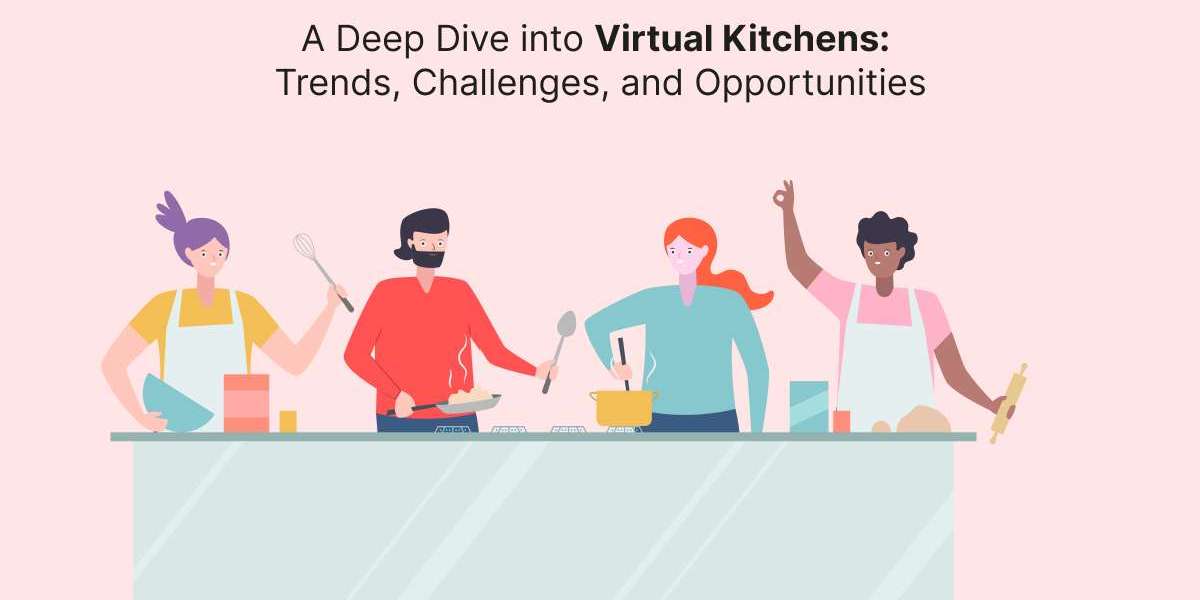Virtual kitchens, also known as cloud kitchens or ghost kitchens, are becoming a popular choice in the food industry. They are changing the way restaurants and food businesses operate by focusing only on food delivery. With no dining areas or front-of-house staff, virtual kitchens work behind the scenes to prepare meals and send them out to customers through delivery apps or their own platforms.
This blog will explore how a virtual kitchen works, the current trends driving their growth, the challenges they face, and the exciting opportunities they offer for food entrepreneurs and tech innovators.
What Are Virtual Kitchens?
The Basics
A virtual kitchen is a commercial cooking space that prepares food specifically for delivery. These kitchens don’t have a dine-in option. Instead, customers place their orders online, and the food is delivered straight to their homes or workplaces. This model cuts down on the costs of running a traditional restaurant and allows businesses to focus purely on the kitchen and delivery.
How They Operate
Most virtual kitchens partner with delivery platforms like Swiggy, Zomato, Uber Eats, or DoorDash. Some also run their own websites or apps for direct ordering. A single virtual kitchen may serve multiple brands or food concepts from one location. For example, one kitchen might prepare pizza under one brand name and Asian food under another, all from the same kitchen setup.
Emerging Trends in Virtual Kitchens
Rise in Online Food Ordering
Online food delivery is growing rapidly. People now prefer to order food with a few taps on their phones rather than dine out. This shift is helping virtual kitchens thrive, as they are built around the idea of digital ordering and quick delivery.
Multi-Brand Kitchens
Virtual kitchens are no longer limited to one food type. Many are operating multiple brands from a single kitchen. This allows them to serve a wider variety of food, cater to more tastes, and test different menus without needing separate locations for each.
Tech-Driven Operations
Technology is playing a big role in how virtual kitchens run. From managing online orders to tracking inventory and predicting customer preferences, smart software and data analysis help streamline kitchen operations and improve customer satisfaction.
Health-Focused Menus
Another trend is the focus on healthy, diet-specific meals. Many virtual kitchens now offer keto, vegan, gluten-free, or low-calorie options to cater to customers who want healthier food without cooking at home.
Sustainability and Eco-Friendly Packaging
Virtual kitchens are also moving toward eco-friendly packaging. Many are using recyclable containers, reducing food waste, and sourcing ingredients from local farms to make their operations more sustainable.
Challenges Faced by Virtual Kitchens
High Competition
As the virtual kitchen concept becomes more popular, competition is increasing. Many businesses are entering the market, making it hard to stand out. Without a physical space or street visibility, virtual kitchens must rely on strong branding and digital marketing to reach their audience.
Dependence on Delivery Platforms
Most virtual kitchens rely heavily on third-party delivery apps to reach customers. These platforms charge high commissions, which can eat into profits. Businesses also have limited control over customer data and delivery experiences when working through third-party apps.
Maintaining Food Quality During Delivery
Food delivery presents its own set of problems. Meals must travel well and arrive hot and fresh. Poor packaging, long delivery times, or careless handling can ruin the customer’s experience and hurt a brand’s reputation.
Staffing and Training
Even though there’s no front-of-house staff, virtual kitchens still need skilled cooks and kitchen managers. Finding and training reliable kitchen staff can be a challenge, especially when running multiple brands from one location.
Licensing and Compliance
Operating a virtual kitchen means following local health codes, food safety regulations, and delivery policies. These rules vary by location and can be complex, especially for entrepreneurs new to the food industry.
Read More: Zomato Clone Scripts | Custom App Development Service
Opportunities in the Virtual Kitchen Space
Lower Startup Costs
Opening a traditional restaurant requires a big investment in space, decor, furniture, and staff. Virtual kitchens offer a more affordable entry point, making it easier for new entrepreneurs to launch a food business with less financial risk.
Fast Market Testing
Because virtual kitchens can operate multiple brands under one roof, it’s easy to test new food ideas and see what works. If a new menu or concept doesn’t perform well, it can be changed quickly without the costs of closing a restaurant.
Expansion Without the Overhead
Successful virtual kitchen brands can expand into new areas by setting up delivery-only kitchens instead of full-service restaurants. This allows businesses to grow quickly and reach more customers without the costs of traditional expansion.
Personalized Food Experiences
With the help of customer data, virtual kitchens can personalize meals based on preferences, order history, and dietary needs. This creates a better customer experience and helps build brand loyalty.
Partnering with Tech Experts
Food brands that want to start or scale virtual kitchens can work with tech professionals to develop their own mobile apps, ordering systems, or kitchen management platforms. These tools improve efficiency, reduce errors, and help businesses stand out from the crowd.
Future of Virtual Kitchens
As customer expectations grow and technology advances, virtual kitchens will continue to evolve. In the future, we may see more automation in cooking, AI-powered kitchen assistants, drone deliveries, and personalized meal subscriptions. The blend of food and technology will keep pushing the boundaries of what’s possible in the delivery space.
Conclusion
Virtual kitchens are transforming the food industry by offering a smart, efficient, and cost-effective way to run a food business. With changing consumer habits, growing demand for online food delivery, and the power of technology, these kitchens offer exciting opportunities for entrepreneurs and brands alike.
But they also come with challenges such as high competition, delivery issues, and dependence on third-party apps. To overcome these hurdles, businesses must focus on quality, innovation, branding, and building the right digital tools to support their operations.
For anyone planning to launch or grow a virtual kitchen brand, working with a skilled clone app development company is key. Whether you need a food ordering app, a backend management system, or a customer feedback platform, the right tech partner can help you succeed in this fast-moving market.

FAQs
What is a virtual kitchen?
A virtual kitchen is a food prep space that operates only for delivery orders. There is no dine-in option, and meals are ordered online through apps or websites.
How is a virtual kitchen different from a regular restaurant?
Virtual kitchens don’t have a physical dining space or front-of-house staff. They focus entirely on preparing food for delivery, making them more efficient and cost-effective.
Are virtual kitchens profitable?
Yes, they can be. With lower overhead costs and growing demand for delivery food, virtual kitchens can make good profits if managed well.
Can I run multiple food brands from one virtual kitchen?
Yes, many virtual kitchens operate several food brands under one roof. This allows businesses to serve different cuisines and customer groups from the same location.
How can I start my own virtual kitchen?
To start a virtual kitchen, you’ll need a licensed kitchen space, a delivery strategy, and strong digital tools for order management. Partnering with an app development company can help you build the tech side of your business efficiently.




